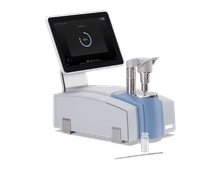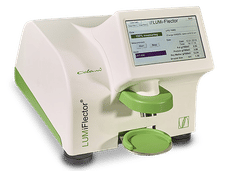An electronic rainbow – perovskite spectrometer by inkjet printing
Advertisement
Researchers from Innovation Lab HySPRINT at Helmholtz-Zentrum Berlin (HZB) and Humboldt Universität zu Berlin (HU) have used an advanced inkjet printing technique to produce a large range of photodetector devices based on a hybrid perovskite semiconductor. By mixing of only three inks, the researchers were able to precisely tune the semiconductor properties during the printing process. Inkjet printing is already an established fabrication method in industry, allowing fast and cheap solution processing. Extending the inkjet capabilities from large area coating towards combinatorial material synthesis opens the door for new possibilities for the fabrication of different kind of electronic components in a single printing step.
Metal halide perovskites are fascinating to researchers in academia and industry with the large range of possible applications. The fabrication of electronic components with this material is particularly appealing, because it is possible from solution, i.e. from an ink. Commercially available salts are dissolved in a solvent and then deposited on a substrate. The group around Prof. Emil List-Kratochvil, head of a joint research group at HZB and HU, focusses on building these types of devices using advanced fabrication methods such as inkjet printing. The printer spreads the ink on a substrate and, after drying, a thin semiconductor film forms. Combining multiple steps with different materials allows to produce solar cells, LEDs or photodetectors in mere minutes.
Inkjet printing is already an established technique in industry, not only for newspapers and magazines, but also for functional materials. Metal halide perovskites are specifically interesting for inkjet printing, as their properties can be tuned by their chemical make-up. Researcher at HZB have already used inkjet printing to fabricate solar cells and LEDs made from perovskites. The inkjet capabilities were further expanded in 2020, when the group of Dr. Eva Unger first used a combinatorial approach to inkjet printing, to print different perovskite compositions in search of a better solar cell material.
Combinatorial printing approach towards industrial production of electronic devices
Now, in this current work, the team around Prof. Emil List-Kratochvil found an exciting application for a large perovskite series within wavelength-selective photodetector devices. “Combinatorial inkjet printing cannot only be used to screen different compositions of materials for solar cell materials,” he explains, “but also enables us to fabricate multiple, separate devices in a single printing step.” Looking towards an industrial process, this would enable large scale production of multiple electronic devices. Combined with printed electronic circuits, the photodetectors would form a simple spectrometer: paper thin, printed on any surface, potentially flexible, without the need of a prism or grid to separate the incoming wavelengths.
Original publication
Vincent R. F. Schröder, Felix Hermerschmidt, Sabrina Helper, Carolin Rehermann, Giovanni Ligorio, Hampus Näsström, Eva L. Unger, Emil J. W. List-Kratochvil; "Using Combinatorial Inkjet Printing for Synthesis and Deposition of Metal Halide Perovskites in Wavelength-Selective Photodetectors"; Advanced Engineering Materials; 2021
Most read news
Original publication
Vincent R. F. Schröder, Felix Hermerschmidt, Sabrina Helper, Carolin Rehermann, Giovanni Ligorio, Hampus Näsström, Eva L. Unger, Emil J. W. List-Kratochvil; "Using Combinatorial Inkjet Printing for Synthesis and Deposition of Metal Halide Perovskites in Wavelength-Selective Photodetectors"; Advanced Engineering Materials; 2021
Organizations
Other news from the department science
These products might interest you

Microspectrometer by Hamamatsu Photonics
Ultra-compact microspectrometer for versatile applications
Precise Raman, UV/VIS and NIR measurements in portable devices

NANOPHOX CS by Sympatec
Particle size analysis in the nano range: Analyzing high concentrations with ease
Reliable results without time-consuming sample preparation

ZEEnit by Analytik Jena
Zeeman Technology for Maximum Sensitivity – Matching any Analytical Problem
Transverse-heated graphite furnace for optimum atomization conditions and high sample throughput

contrAA 800 by Analytik Jena
contrAA 800 Series – Atomic Absorption. Redefined
Multi-element analysis and ease of use at a manageable cost

SPECORD PLUS by Analytik Jena
SPECORD PLUS Series - Maximum precision in UV/Vis
The modern classic guarantees the highest quality

NEX CG II by Applied Rigaku Technologies
Elemental analysis at ppb level for exact results

ERASPEC by eralytics
Spectral Fuel Analysis in Seconds with ERASPEC
Fast delivery of over 40 fuel parameters at the push of a button

ALPHA II by Bruker
Chemical analysis made easy: compact FT-IR system
Increase the efficiency of your routine analyses with user-friendly technology

INVENIO by Bruker
FT-IR spectrometer of the future: INVENIO
Freely upgradeable and configurable FT-IR spectrometer

Micro-Z ULS by Rigaku
Accurately measure sulphur content in fuels: WDXRF analyser
Reliable routine analyses with 0.3 ppm detection limit and compact design

PlasmaQuant MS-Serie by Analytik Jena
Mass spectrometers for highly sensitive research applications and lowest detection limits
The formula for success in LC-ICP-MS – PlasmaQuant MS series and PQ LC

novAA® 800 by Analytik Jena
The Analyzer 4 You - novAA 800-Series
The reliable all-rounder, making routine analysis efficient and cost-effective

S2 PICOFOX by Bruker
Fast and precise trace element analysis on the move
TXRF technology for minimal samples and maximum efficiency

S4 T-STAR by Bruker
TXRF spectrometer: Sub-ppb detection limits & 24/7 analytics
Minimal operating costs because no gases, media or lab equipment are required

ZSX Primus IVi by Rigaku
High-precision WDXRF analysis for industrial applications
Maximum sensitivity and throughput for light elements and complex samples

Agera by HunterLab Europe
Save Valuable Time: Color and Gloss Measurement in Record Time
Capture the Color Impression of the Sample Exactly as the Human Eye Perceives It

Renting and Leasing Solutions for Laboratories by Bios Analytique
Specialists in the rental and leasing of scientific equipment for laboratories throughout Europe
Whether you have an unexpected requirement or limited budget, we have the perfect solution for you

Quantaurus-QY by Hamamatsu Photonics
High-speed UV/NIR photoluminescence spectrometer
Precise quantum yield measurements in milliseconds without reference standards

SITRANS TDL by Siemens
Efficient process gas monitoring in real time
Robust in situ spectrometer for non-contact measurements without sample preparation

LUMiFlector by LUM
Inline & Atline MRS Spectrometer for Determination of Product Properties within a Few Seconds
It determines fat, protein and dry matter content in milk and dairy products

Get the chemical industry in your inbox
By submitting this form you agree that LUMITOS AG will send you the newsletter(s) selected above by email. Your data will not be passed on to third parties. Your data will be stored and processed in accordance with our data protection regulations. LUMITOS may contact you by email for the purpose of advertising or market and opinion surveys. You can revoke your consent at any time without giving reasons to LUMITOS AG, Ernst-Augustin-Str. 2, 12489 Berlin, Germany or by e-mail at revoke@lumitos.com with effect for the future. In addition, each email contains a link to unsubscribe from the corresponding newsletter.
































































